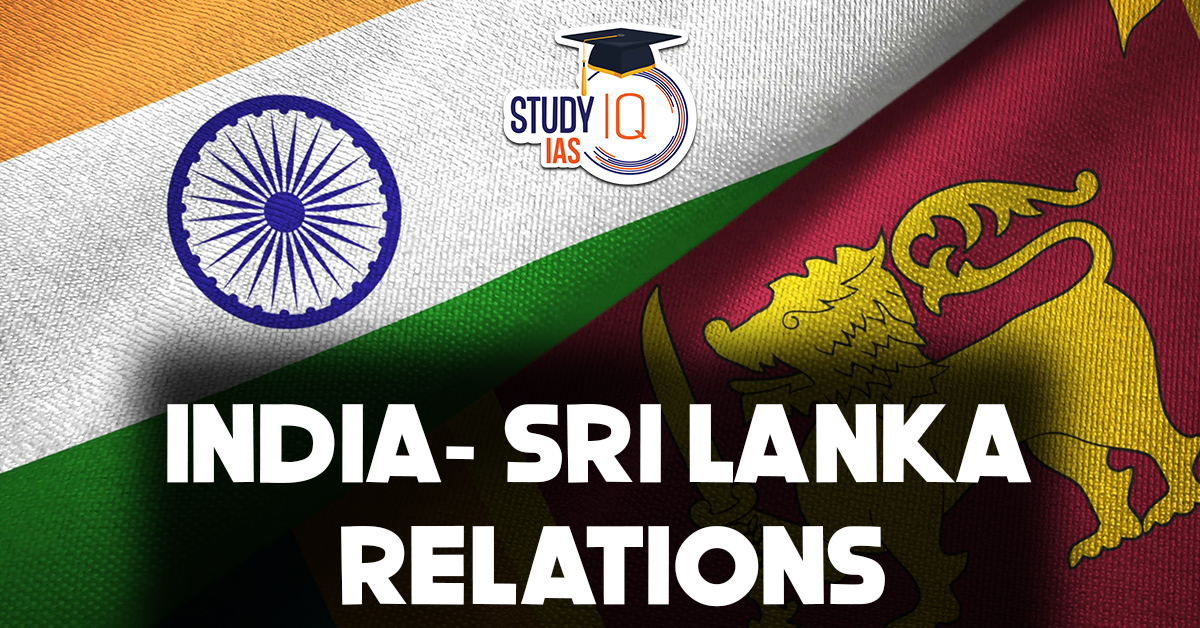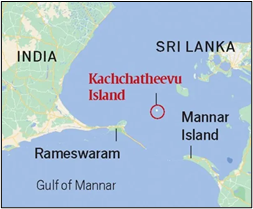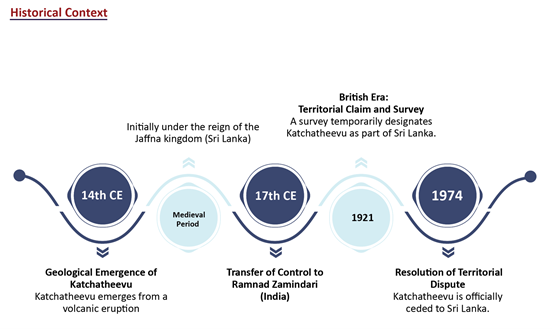Table of Contents
Context: India has named the Jaffna Cultural Centre after Tamil poet-philosopher Thiruvalluvar, signifying India’s enduring cultural and historical ties with Sri Lanka.
More in News
- Originally, Sri Lankan Tamils expressed concern over the omission of ‘Jaffna’ from the name, prompting swift action from Indian authorities to rename it the Jaffna Thiruvalluvar Cultural Centre.
- This centre, built by India, serves as a cultural landmark and reinforces the deep-rooted connection between the two nations.
Historical Context of India-Sri Lanka Political Relations
Since the anti-Tamil riots in 1983, India has played various roles in Sri Lankan politics, including mediating during civil conflicts and supporting constitutional reforms like the Indo-Lanka Accord of 1987, which led to the establishment of Provincial Councils under the 13th Amendment.
13th Amendment to the Sri Lankan Constitution
- The 13th Amendment (13A) to the Constitution of Sri Lanka was introduced in 1987 as part of the Indo-Lanka Accord between India and Sri Lanka.
- It aimed to address the long-standing ethnic conflict by providing devolution of power to the provinces, particularly benefiting the Tamil-majority Northern and Eastern Provinces.
Key Features of the 13th Amendment
- Creation of Provincial Councils: Established 9 Provincial Councils, each with limited legislative and executive powers.
- Marked the first attempt at decentralized governance in Sri Lanka.
- Powers of the Provincial Councils: Devolved powers on subjects like education, health, agriculture, land, and police.
- Certain subjects remained under Central Government control, including national security and finance.
- Official Status for Tamil Language: Recognized Tamil as an official language, alongside Sinhala, and an administrative language at the provincial level.
- Merger of Northern and Eastern Provinces (Later Annulled)
- Allowed the temporary merger of the Northern and Eastern provinces into a single Tamil-majority unit.
- In 2006, the Sri Lankan Supreme Court annulled the merger, restoring them as separate provinces.
Significance of 13A
- Seen as a compromise solution to Sri Lanka’s ethnic conflict.
- Represents the only constitutional provision offering devolution of power to Tamil-majority regions.
- Continues to be a point of contention in Sri Lankan politics, with Tamil groups demanding its full implementation and Sinhala nationalist parties advocating its repeal.
Challenges and Status
- Despite being part of the Sri Lankan Constitution for over 35 years, 13A has never been fully implemented.
- Provinces lack control over police and land administration, despite constitutional provisions.
- Successive Sri Lankan governments have resisted its full implementation, fearing it would lead to separatism.
- The JVP and nationalist parties have opposed 13A, viewing it as an imposition by India.
- India has consistently urged Sri Lanka to implement the amendment fully as a means to address Tamil grievances.
Current Situation
- While Provincial Councils functioned from 1988 to 2019, their powers remain weak.
- No Provincial Council elections have been held since 2019, delaying the democratic process.
- The new JVP-led government has not clarified its stance on full implementation or repeal of 13A.
- Prime Minister Modi’s silence on 13A in December 2024 has raised speculation about India’s evolving stance.
Areas of Cooperation Between India and Sri Lanka
Economic and Infrastructure Development
- Projects like the Kankesanthurai Port and the Trincomalee Oil Tank Farm.
- Indian financing for an undersea oil pipeline and an electricity transmission line for Sri Lanka’s energy security.
- Conversion of seven Line of Credit projects worth $20 million to grants.
Trade and Investment
- Sri Lanka is one of India’s largest trading partners in SAARC.
- India and Sri Lanka reached USD 5.5 billion in FY 2023-24.
- Tourism is another important component with India being the leading tourist source market.
Energy Cooperation
- India to supply LNG gas to Sri Lanka to support energy needs.
- Sri Lanka is dependent on India for refined petroleum
Defence and Security
- Sri Lanka’s strategic role in India’s SAGAR (Security and Growth for All in the Region)
- India continues to be the largest provider of foreign training assistance to the Sri Lankan Armed Forces.
- Bilateral SLINEX (Naval Exercise) and MITRA SHAKTI (Army Exercise) are held every year alternatively in India & Sri Lanka, Sri Lanka participates in MILAN, the multilateral naval exercise hosted by the Indian Navy.
Community and Social Support
- India supports the aspirations of all communities in Sri Lanka, including the Tamil minority.
- India has provided multi-faceted assistance to Sri Lanka, close to USD 4 billion, during the economic crisis in 2022.
- Buddhism, spread by Ashoka is one of the strong pillars connecting both Nations.
- Cooperation in education and technology exchanges to boost social development.
Multilateral: Sri Lanka is a member of regional groupings like BIMSTEC (Bay of Bengal Initiative for Multi-Sectoral Technical and Economic Cooperation) and SAARC in which India plays a leading role.
| Need to Enhance Ties With Sri Lanka |
Enhanced cooperation with Sri Lanka is crucial given the challenges India faces in its immediate neighbourhood.
|
Concerns
- China’s Influence: China’s involvement in developing strategic assets like the Hambantota Port raises security concerns for India.
- Tamil Minority Issues: The need to address the aspirations of Sri Lanka’s Tamil minority, especially concerning the implementation of the 13th Amendment for devolution of power.
- Fishermen Dispute: Frequent disputes over Tamil Nadu fishermen straying into Sri Lankan waters (such as near Katchatheevu Island), leading to arrests and tensions.
- Economic Vulnerabilities: Sri Lanka’s heavy reliance on external debt and need for continued IMF support pose challenges for economic stability.
| Katchatheevu Island |
|
Way Forward
- Strategic Balance with China: Continued Indian investments and infrastructure support to counterbalance China’s influence.
- Ensuring Sri Lanka’s maritime policies are aligned with India’s security interests.
- Resolving Tamil Minority Issues: Supporting the implementation of Sri Lanka’s 13th Amendment.
- Engaging diplomatically to ensure the rights of the Tamil minority are respected.
- Coordinated Fishing Agreements: Establish a coordinated fishing model to reduce tensions over fishing disputes.
- Governance and Anti-Corruption Initiatives: India can assist in governance reforms, digitization, and modernization of agriculture in Sri Lanka.
- Strengthening Economic Ties: Expediting an upgraded Free Trade Agreement (FTA) by 2025 and a comprehensive trade deal by 2026.
- Piloting a regional Production-Linked Incentive (PLI) 2 scheme in Sri Lanka to boost mutual business interests.
- Broaden business collaboration to include more sectors (food processing, textiles and garments, auto parts, and IT-related services) and regions (all four southern Indian states).
- Enhanced Connectivity: Improve physical connectivity for trade and tourism.
- Economic Stability Initiatives: Providing aid and trade-related assistance to bolster economic recovery.




 India-Middle East-Europe Economic Corrid...
India-Middle East-Europe Economic Corrid...
 US-Iran Nuclear Talks: Key Developments ...
US-Iran Nuclear Talks: Key Developments ...
 EU Plans to Slash General Data Protectio...
EU Plans to Slash General Data Protectio...





















